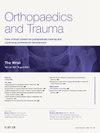Intra-articular injections for the management of knee osteoarthritis
Q4 Medicine
引用次数: 0
Abstract
Osteoarthritis (OA) of the knee is a degenerative disease with complex pathophysiology which affects the whole joint, resulting in pain, stiffness and progressive functional limitation. It presents a significant global socioeconomic health burden and necessitates cost-effective, efficacious and safe solutions. Intra-articular injections of different preparations form a non-operative treatment modality for knee OA, reserved for where conservative measures such as physiotherapy and oral analgesia are insufficient, but where arthroplasty is not yet indicated. Intra-articular injections provide a large concentration of the desired agent directly to the affected tissues, avoiding the side effect profiles of systemic treatments. They can be categorized into non-biologic and biologic therapies, with different treatment protocols. ‘Orthobiologics’ is a relatively new and rapidly evolving area in the treatment of knee OA, targeting specific molecular pathways in the OA pathogenesis. The most common intra-articular injections in clinical practice are corticosteroids, viscosupplementation (hyaluronic acid, HA) and autologous blood products such as platelet-rich plasma (PRP). The efficacy of different preparations remains controversial, with both biologic and non-biologic treatments appearing in professional guidelines for the management of knee OA. Inconsistencies in the guidelines and heterogeneity in study methodology result in an academic field that is potentially difficult to navigate for clinicians, worsened by ambiguous nomenclature and low-quality evidence. The aim of this review is to provide an overview of the most frequently used intra-articular injections for knee OA, focussing on mechanism of action, current evidence and professional recommendations.
膝关节骨关节炎的关节内注射治疗
膝关节骨关节炎(OA)是一种具有复杂病理生理的退行性疾病,可影响整个关节,导致疼痛、僵硬和进行性功能限制。它构成了重大的全球社会经济卫生负担,需要具有成本效益、有效和安全的解决办法。关节内注射不同制剂形成了膝关节OA的非手术治疗方式,用于物理治疗和口服镇痛等保守措施不足,但尚未需要关节置换术的情况。关节内注射提供大浓度的所需药物直接到受影响的组织,避免了全身治疗的副作用。它们可以分为非生物疗法和生物疗法,采用不同的治疗方案。“骨科”是膝关节OA治疗中一个相对较新的和快速发展的领域,针对OA发病机制中的特定分子途径。临床实践中最常见的关节内注射是皮质类固醇、粘质补充剂(透明质酸、透明质酸)和自体血液制品,如富血小板血浆(PRP)。不同制剂的疗效仍然存在争议,生物和非生物治疗均出现在膝关节OA治疗的专业指南中。指南的不一致性和研究方法的异质性导致学术领域的临床医生可能难以驾驭,模糊的命名和低质量的证据使情况恶化。本综述的目的是概述膝关节OA中最常用的关节内注射,重点是作用机制、现有证据和专业建议。
本文章由计算机程序翻译,如有差异,请以英文原文为准。
求助全文
约1分钟内获得全文
求助全文
来源期刊

Orthopaedics and Trauma
Medicine-Orthopedics and Sports Medicine
CiteScore
1.00
自引率
0.00%
发文量
57
期刊介绍:
Orthopaedics and Trauma presents a unique collection of International review articles summarizing the current state of knowledge and research in orthopaedics. Each issue focuses on a specific topic, discussed in depth in a mini-symposium; other articles cover the areas of basic science, medicine, children/adults, trauma, imaging and historical review. There is also an annotation, self-assessment questions and a second opinion section. In this way the entire postgraduate syllabus will be covered in a 4-year cycle.
 求助内容:
求助内容: 应助结果提醒方式:
应助结果提醒方式:


